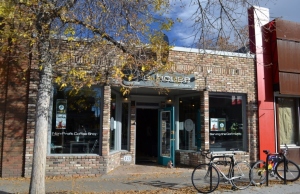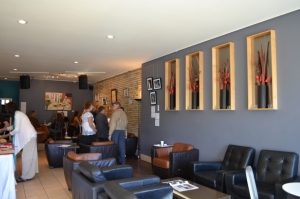Earlier today I was in the community of Kensington. I stopped in to attend an exhibition opening at The House Coffee Sanctuary.
I periodically stop in at The House for a coffee and pastry as I like to support small independent businesses if I am able. As a previous small business owner, I find that they are the lifeblood of our communities and that they usually reinvest into the communities where they are based, more than do most of the larger multi-national companies. Whenever I do stop in for a coffee, I have always noticed art on the wall. Like many other independent coffee shops and restaurants they feature art to decorate the space and “provide publicity” to artists.
As a former gallerist, I am of two minds about this practice. Others are as well I am very certain, probably for other reasons. I have provided art to these type of places (coffee shops, restaurants, etc.) and have had the art stolen off the wall. As a result, I have had to purchase the stolen art using funds out of my own pocket. Let’s just say that, “once burned, twice shy” would help explain my feelings toward these type of venues as an art exhibition space. It is hard enough to make a living in the arts as it is, I don’t need the additional stresses of financial success (or failure) that comes as a result of someone else’s whims or desires. I am not a big fan as a result. But that is my own personal experience and not everyone else’s. If it works for others – that is great.
* * *
This is something that I have wanted to write about for some time. The whole concept of small artist groups who rarely, if ever, get any mention.
The exhibition I attended today featured members of one of these groups, The Emmaus Fine Art Group.
Chances are most readers of my blog will not know who these members are. That is understandable as there are many societies or artist groups such as this in the city. There is a long tradition of arts organizations such as this which pre-date the first museum that showed art in the city. As a result, these type of groups are part of my research focus.
Some groups are more well- known than others – groups such as the Alberta Society of Artists, the Canadian Federation of Artists, Burns Visual Arts Society, Untitled Art Society, Alberta Printmakers Society, Bee Kingdom . . . the list goes on, and on. Other groups slip under the radar screen for most that are interested in the visual arts, for various reasons. It is certainly not because they are any less worthy.
What are artist societies?
- These groups can be a very small group of artists or they can be quite large;
- They can offer free membership or paid;
- They may provide studio space – or not;
- A group could be as simple as a few retirees or stay at home moms who paint. They may form a group out of a need, or an excuse to get out of the house, meet their friends for coffee or a glass of wine, and talk about their work, or paint en plain air as a group;
- They may meet once a week, once a month, once a year or not at all except for board elections;
- Alternatively, a group could be a formalized society with its own bylaws, non-profit status and space;
- The group can take whatever form that they choose, and for whatever reason that makes sense to its members.
Regardless of how they are formed or operate, they are all community-building initiatives. They also serve a number of positive purposes such as:
- Providing a support mechanism for what is usually a solitary pursuit (producing visual art and/or craft-based work);
- Provide exhibition opportunities that may not otherwise occur;
- Provide a reason to produce work;
- Provide a social network with like-minded individuals.

